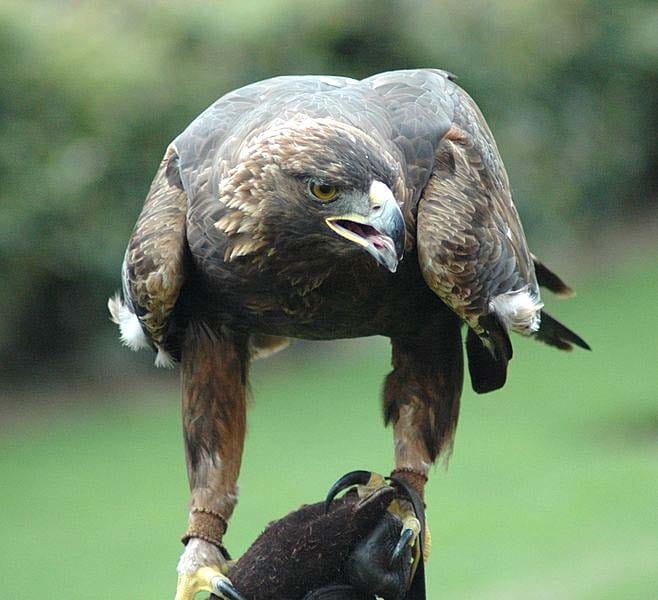The Golden Eagle (Aquila chrysaetos) is one of the largest and most powerful birds of prey in the world. The two species of eagles in North America, the bald and the golden eagle, both reside in Alaska in healthy numbers and nest in the Interior. There are more bald eagles(Haliaeetus leucocephalus) in Alaska than in all the other 49 states combined, but the golden eagle is more typically found in the Denali area.
A large bird that can weigh up to 12 pounds, the golden eagle has a broad wing spread that can reach to more than 7 feet. Like many raptors, the females are considerably larger than males. The overall color is dark brown with the color on the head and neck a lighter golden brown to very light blond. Young birds are darker with the golden tones of the head and neck less pronounced. Immature birds also have white at the base of the tail and irregular white patches under the wings which disappear when the bird becomes an adult.
Identification of young eagles is sometimes confusing. The bald eagle is much the same in size and color as golden eagles under 3 years old except that the golden eagle shows white at the bse of its black-tipped tail. Another noticeable difference is the golden eagle’s legs, which are feathered down to the toes, whereas the lower legs of the bald eagle are bare. At 3 years of age the feathers on the head, neck and tail of the bald eagle turn white.

Unlike the bald eagle, which is primarily a fish eater, the golden eagle is a fierce and powerful hunter. It uses its long, sharp claws to kill its prey and its strong, hooked beak to tear the meat into bite-size pieces. The birds have been observed carrying to their nest animals as large as snowshoe hares, which weigh as much as four pounds. The golden eagle eats and feeds its young a wide variety of birds and mammals, such as ptarmigan, Arctic ground squirrels, hoary marmots and ofcourse, snowshoe hares.
The nests, or aeries, of golden eagles are found in a variety of places, including in trees at low elevations and more commonly in Denali, on ledges and cliffs high in the mountains. Aeries vary in size from 3 feet across and as many feet deep to platforms 5 feet wide and only a foot deep. The nest, made up of dead sticks, may be used for many years and will be cleaned up and refurbished each season until the wind or the nests weight makes it tumble to the ground.
A pair of eagles may mate for life and will establish and defend a territory around the nest. In Alaska eagles may lay eggs as early as late March or early April..This is always preceded by a courtship, which includes some breathtaking aerial acrobatics, and may continue through the entire nesting season. The female usually lays two and rarely three large, smoth eggs. Like many norther predators, the reproductive success of Golden Eagles is higher when population cycles of snowshoe hare and willow ptarmigan are high. Eggs hatch in 45 days.
Golden eagles are wary of man. If molested, the female might desert a nest with eggs but she will not desert the young. The hatchlings are covered with thick, white down to keep them warm. Down is replaced with feathers at eight weeks and by 11 or 12 weeks the young are nearly full grown and are practicing flapping their wings and hanging suspended by the wind for increasingly long periods of time.
As birds go, golden eagles are long-lived. They have been recorded to live up to 30 years of age in the wild. Denali National Park and Preserve is one of the best places in Alaska to watch golden eagles in the summer, though very few will overwinter in the Interior and northern Alaska. Studies show that most of Denali’s eagles will winter as far east as Kansas, as far south as northern Mexico and as far west as Idaho.
These beautiful raptors have captured people’s imagination throughout history. Soaring above the world, in search of prey or migrating to distant lands, they epitomize freedom and strength. But they have also been hunted because they compete with human hunters for game and have preyed on some domestic animals. Thanks to organized conservation efforts and a growing awareness of the fragility of wildlife, golden eagles have become increasingly valued and protected in North America and continue to grace our Alaskan skies with their regal presence.



